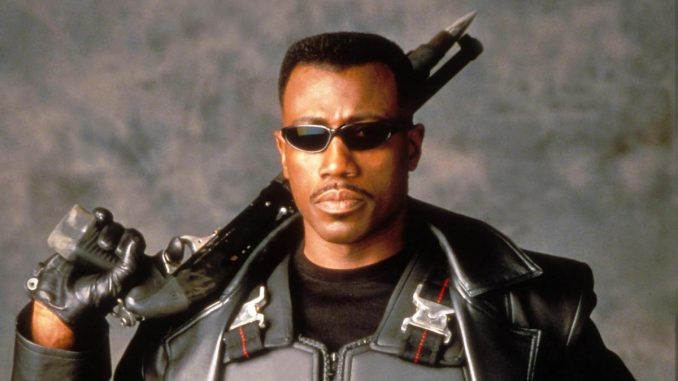
Poor Blade. With all the fuss over Black Panther, as the image below shows, it’s clear that the world forgot who was actually Marvel’s first black superhero, almost two decades before T’Challa hit the screen. Despite being successful enough to spawn sequels in 2002 and 2004, grossing a total of $415 million worldwide, it seems the daywalker was perhaps too far ahead of his time. Certainly, back in 1998, Marvel was a company in big trouble, far from the juggernaut it has since become. Its reputation had never climbed out of the cinematic toilet: need I say any more than Howard the Duck?
After filing for Chapter 11 protection in December 1996, the company was re-organized. The new version began pushing previously minor characters, including both Blade and Black Panther, though movie adaptations of both had already been bouncing around for a few years. In 1992, Variety reported that LL Cool J was connected to the role of Blade, while Black Panther was going to be played by… Wesley Snipes. I suspect we would living in a very different universe had those movies been made as originally cast. Denzel Washington and Laurence Fishburne were also considered as potential Blades.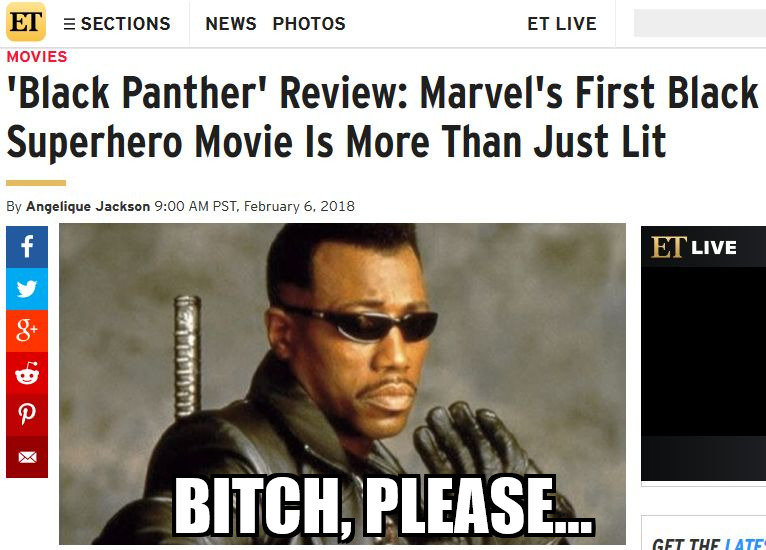
It’s worth noting that the movie version of Blade influenced the comic-books, arguably more than the comic-books ever did the movies. And right from the start, the franchise was rated R and proud of it – again, a long time before Deadpool opened his potty mouth. And one wonders if it would have happened at all, if Ryan Reynolds hadn’t called Parker Posey a “cock-juggling thundercunt” in Blade: Trinity. The influence from its style on those which followed cannot be over-estimated. Without Blade, there likely would have been no Selene in Underworld, and arguably even Neo in The Matrix might not have adopted his trenchcoat and dark glasses.
This re-view of the three movies in the franchise (let’s not talk about the abortive TV series) was triggered after brushing against part of Blade: Trinity on the SyFy channel. Seeing the woeful way in which it had been edited for basic cable consumption – King’s sticker blurred out to a meaningless “Hello, my name is you” – made us resolve to watch the film in the manner intended. From there, it was but a short hop, skip and a jump to the DVD archives, and the decision to embark on a marathon session of all three movies. This is certainly Snipes’s most iconic character, although Simon Phoenix in Demolition Man pushed it close (why that never became a franchise, I’ll never understand. I’m adding that one to the pile for a future re-view).
Will there ever be a Blade 4? The market is certainly a great deal more friendly to comic-book films than when the franchise was breaking new ground in the late nineties. And Snipes is certainly up for it, saying last August, “There are a lot of conversations going around right now and we’re very blessed to have the enthusiasm and interest in something coming from that world again… All the main execs [at Marvel] and my team, we’ve been discussing for the past two years. Everyone’s enthusiastic about it, everybody gets it. But they got a business to run.” If it happens, let’s just hope that Snipes keeps a better hold of his tax accountant.
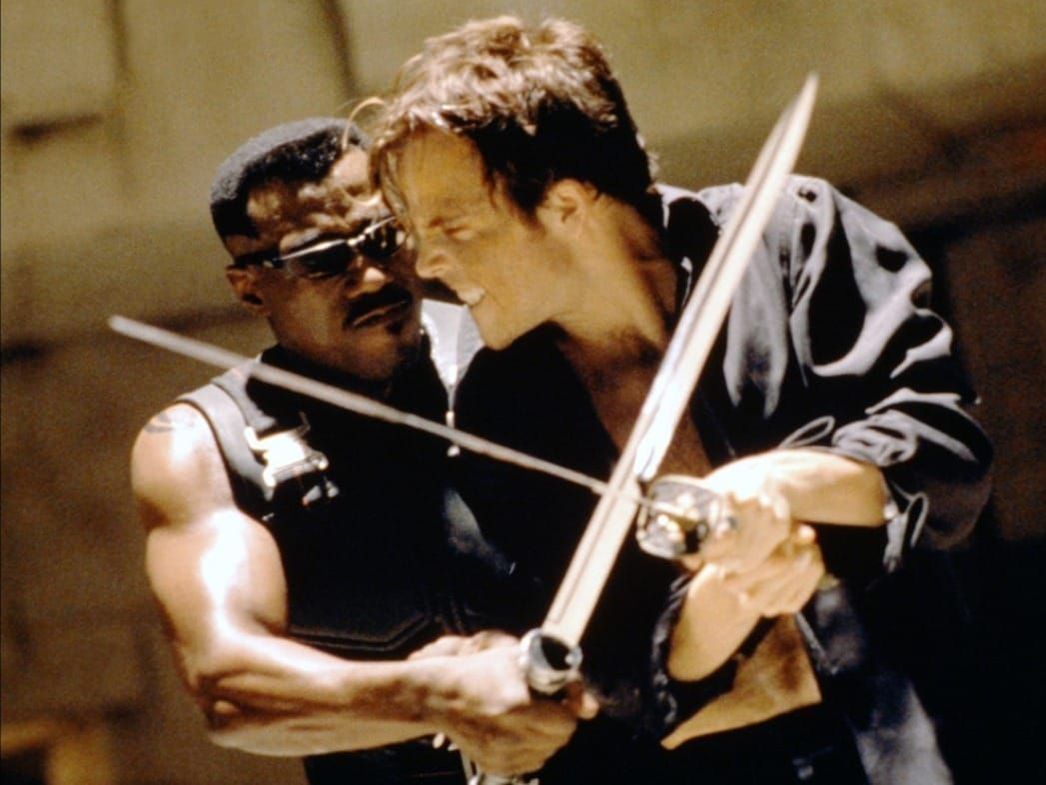
Blade (1998)
Rating: B-
Dir: Stephen Norrington
Star: Wesley Snipes, Stephen Dorff, N’Bushe Wright, Kris Kristofferson
While they never quite die entirely, it feels as if vampire movies go through about a ten-year cycle of popularity. If so, we’re due for another burst, with the last surge having been around 2007-08. That was focused on the mopey teenage romance of Twiglet, but also gave us Let the Right One In and 30 Days of Night. Blade formed part of the previous lap, along with John Carpenter’s Vampires, which came out two months later in 1998. Though Vampires had considerably less success: below 30% of Blade’s box-office take, despite a similar, R-rated approach.
In an era where it seems there’s a new Marvel film out every other weekend [seriously: less than four months this year will cover Captain Marvel, Avengers: Endgame and Spider-Man: Far From Home], it’s amazing to think that Blade was their first American theatrical release for twelve years. Since Howard the Duck in 1986, Captain America and The Punisher had gone straight to video, while 1994’s The Fantastic Four went entirely unreleased. With its hero very much a minor property, this was a cautious dip of the toe by Marvel back into cinema. While the $45 million budget was not small, inflation-adjusted it was about $9 million less than Howard. Money considerably more well-spent, however.
 For this is a great deal better, mostly due to a script which does a fine job of giving us the back story of Blade (Snipes) and developing his character, while pushing forward his battle against upwardly-mobile vamp Deacon Frost (Dorff). Frost wants to summon the vampire’s blood god, La Magra, and obtain its powers. In an interesting if under-explored angle. he’s seen as yuppie scum by the elders, because he was “turned” into a vampire rather than being born one. [Delightful to see one of the elders played by Udo Kier, returning again to the field he occupied in Blood for Dracula]. Meanwhile, Blade is helped by grizzled veteran Whistler (Kristofferson) and hematologist Dr. Karen Jenson (Wright), who comes up with a vaccine, as well as EDTA, a compound which makes vamps explode real good.
For this is a great deal better, mostly due to a script which does a fine job of giving us the back story of Blade (Snipes) and developing his character, while pushing forward his battle against upwardly-mobile vamp Deacon Frost (Dorff). Frost wants to summon the vampire’s blood god, La Magra, and obtain its powers. In an interesting if under-explored angle. he’s seen as yuppie scum by the elders, because he was “turned” into a vampire rather than being born one. [Delightful to see one of the elders played by Udo Kier, returning again to the field he occupied in Blood for Dracula]. Meanwhile, Blade is helped by grizzled veteran Whistler (Kristofferson) and hematologist Dr. Karen Jenson (Wright), who comes up with a vaccine, as well as EDTA, a compound which makes vamps explode real good.
Most of this has dated quite well, save for the occasional bit of ropey CGI. Snipes embodies his character from the very first time we see him, posing in the vampire club. It’s clear he’s a bad motherfucker – though speaking of which, there seemed to be rather more Oedipal overtones than I remembered. The biggest weakness here is probably Jenson. She serves so little point, I wonder if her character was originally added a romantic interest, only for that angle to be eliminated. The finale could also have used quite a bit of tightening: Frost’s summoning ritual seems to go on for a good chunk of the 120-minute running time, when all we want to see is Blade kick ass.
And that he eventually does, with sharp aplomb, and shades so solidly locked on his head, they must be nail-gunned to his temples. One can only wonder how much more bottom might have been beaten, had Jet Li agreed to play Frost, rather than do Lethal Weapon 4. Still, Snipes inhabits the role, to such an extent that it’s impossible to imagine anyone else in the part. I’m not sure you can say the same about, for example, any member of the Avengers. While the spectacle of Marvel movies may have increased in scope since, I’m not sure they have produced a more stylish lead character.
What we said at the time: Blade features some of the most impressive, intense and, well, crunchiest violence I’ve seen at the cinema for a very long time. Snipes is fine as the hero, Dorff makes an impressive villain (despite a startling resemblance to Kiefer Sutherland) and even Kris Kristofferson, Blade’s sidekick is good enough. Plus you’ve got Kier and Lords in minor roles.
So why doesn’t it work? Could it be because the script is half-written dreck? One presumes it’s all explained a great deal better in the comic books, because it certainly ain’t here. It’s the usual apocalyptic and millenial nonsense, with Dorff attempting to summon the spirit of some vampire god or other because…well, just because, alright? N’Bushe Wright [what kind of a name is that? N’Bushe?] also fails miserably as love-interest-cum-haematologist. I’d use the word “anaemic” except that would be unforgivably painful.
There’s certainly a lot of stuff here to enjoy, but you’ll probably find yourself reaching for the fast-forward to find the next session of excessive and gratuitous violence. Which may be a problem if you’re in the cinema…
10 people you might have forgotten appeared in the Blade franchise
- Eric Bogosian: the star of Talk Radio plays – appropriately enough – a talk-show host in Trinity.
- Tony Curran: Vincent van Gogh from Doctor Who is one of the Bloodpack, the vampires fighting alongside Blade through necessity in the second film.
- Luke Goss: in 1988 Britain, you couldn’t move for fucking Bros, the boy band of all boy bands. 14 years later and entirely forgotten, one of them played the ugliest vampire of all time in Blade II.
- Danny John-Jules: Yes, thank you for asking. That is Cat from Red Dwarf, portraying another one of the Bloodpack.
- Sanaa Lathan: Tony award nominee Lathan plays Blade’s mother in the original film – despite being nine years younger than Snipes. Vampirism truly is a remarkable thing.
- Shannon Lee: daughter of Bruce and sister of Brandon, she shows up in a very quick role as “Resident” in Blade.
- Donal Logue: the psychotic US Marshal from Sons of Anarchy is a minion of Frost in the opening installment, and keeps losing his hands to the hero.
- Traci Lords: everyone’s favorite under-age porn starlet is the inaugural vampire seen, luring an unwitting victim to their nightclub early in the first film.
- Patton Oswalt: he’s the Night Stalkers’ tech guru in Trinity.
- Donnie Yen: one of the all time best cinematic martial-artists, and also in the Bloodpack. Shame he doesn’t get the glorious death Ip Man deserves.
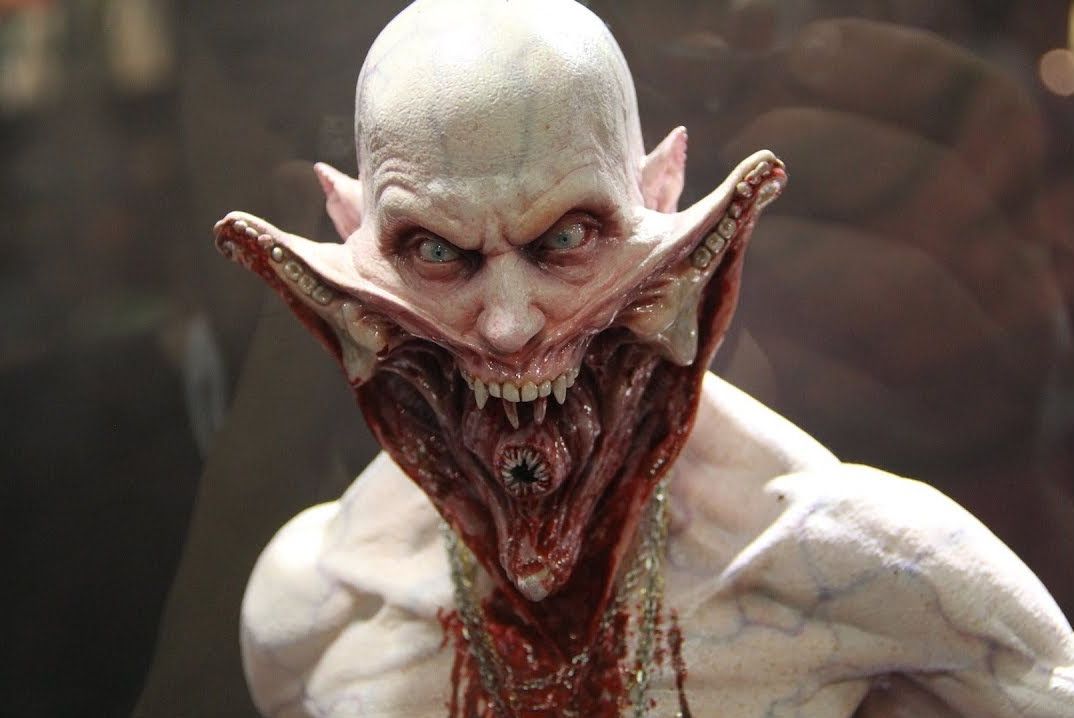
Blade II (2002)
Rating: A-
Dir: Guillermo del Toro
Star: Wesley Snipes, Luke Goss, Kris Kristofferson, Norman Reedus
While in hindsight, del Toro was an obvious choice. at the time he still seemed considerably more arthouse than commercial. His only English-language film had been Mimic, which failed to cover its budget at the box-office. However, its style caught the eye of New Line, and Del Toro was offered the director’s chair in the sequel after the previous incumbent declined to return. This was a poor decision by Stephen Norrington: he went on to make The League of Extraordinary Gentlemen, an experience so horrific, Norrington vowed never to direct again. del Toro, meanwhile, created what is, for me, the best movie with which either Marvel or DC have been involved, as well as one of the best vampire films ever.
What stands out is that he 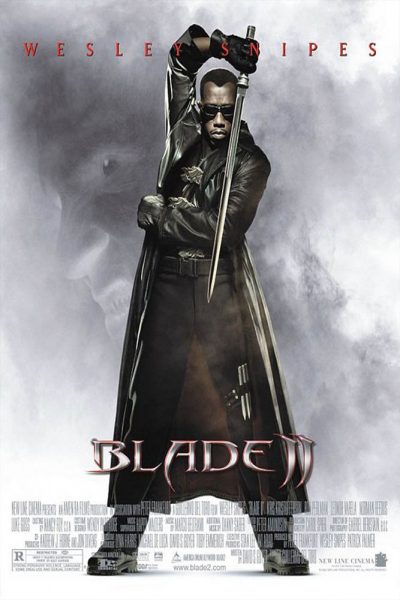 took what worked about the first film, and enhanced it – in a way, similar to how James Cameron upped the ante for his sequel to Alien. For example, if facing one vampire is bad, then facing a multiplying army of them must be far worse. Indeed, there are some sequences, such as when Blade and the Bloodpack are exploring the nightclub, which are very reminiscent of Aliens: you just know the shit is going to hit the fan; it’s a question of when. The various characters in the Bloodpack have a cocky, Marine-like swagger to them too, even if not quite reaching the iconic level of Hudson, Hicks and Vasquez. [Donnie Yen’s presence is felt more in the martial arts, which he helped choreograph, and are improved all round]
took what worked about the first film, and enhanced it – in a way, similar to how James Cameron upped the ante for his sequel to Alien. For example, if facing one vampire is bad, then facing a multiplying army of them must be far worse. Indeed, there are some sequences, such as when Blade and the Bloodpack are exploring the nightclub, which are very reminiscent of Aliens: you just know the shit is going to hit the fan; it’s a question of when. The various characters in the Bloodpack have a cocky, Marine-like swagger to them too, even if not quite reaching the iconic level of Hudson, Hicks and Vasquez. [Donnie Yen’s presence is felt more in the martial arts, which he helped choreograph, and are improved all round]
The chief monster (Goss) is every bit as inventively horrific as anything from the mind of H.R. Giger, with its face which splits open at the chin to reveal fangs and barbed tentacles. This mutant vamp clearly put all its ability points into the “Jesus, what the fuck is that?” skill. Yet, it turns out to have a surprising humanity beneath its ugly exterior. This is not uncommon in Del Toro’s work, most obviously The Shape of Water; though fortunately, no-one gets to have sex with the monster here. Arguably, the true villain is Eli Damaskinos (Thomas Kretschmann), the head vampire. Unlike the slick, suit-wearing elders of the first film, Damaskinos has much more in common with a classic Nosferatu-type.
In terms of people whose presence here now seems particularly out of place, the prize has to go to Reedus, playing Blade’s geek, an archetypal nerd who eats Krispy Kreme donuts and watches The Powerpuff Girls. Despite battling similarly post-mortem opponents, it’s hard to imagine a character further from from The Walking Dead‘s Darryl. [Reedus’s first movie role was for Del Toro, in Mimic] Yet he’s still a fine part of the ensemble, with Ron Perlman also worthy of note. He, too, had worked with Del Toro before, appearing in the director’s feature debut Cronos in 1993. I kinda wonder why Doug Jones didn’t take Goss’s role.
Although (just) the shortest of the trilogy, it definitely feels as if it has the most invention and imagination crammed into it. This two-hour film feels closer to 80 minutes long, with remarkably little slack and offering a steady stream of memorable moments. I’m not surprised even John Carpenter couldn’t match it.
 What we said then: Yes, that Luke Goss, former teen idol as part of Bros, last seen at the Fairfield Halls, Croydon, in a musical version of Plan 9 from Outer Space. He does not break into When Will I Be Famous?, but seeing his name in the credits was probably a bigger shock than anything in the movie (even surpassing Cat from Red Dwarf showing up). Still, this was a very solid effort, complete with some of the most eye-popping gore I’ve seen in quite a while, occasionally reaching The Thing standard. Snipes is back, teaming up with vampires to fight a new menace (Goss), whose mode of attack really needs to be seen to be believed – you’ll certainly look nervously at anyone with a cleft chin on the way out of the cinema.
What we said then: Yes, that Luke Goss, former teen idol as part of Bros, last seen at the Fairfield Halls, Croydon, in a musical version of Plan 9 from Outer Space. He does not break into When Will I Be Famous?, but seeing his name in the credits was probably a bigger shock than anything in the movie (even surpassing Cat from Red Dwarf showing up). Still, this was a very solid effort, complete with some of the most eye-popping gore I’ve seen in quite a while, occasionally reaching The Thing standard. Snipes is back, teaming up with vampires to fight a new menace (Goss), whose mode of attack really needs to be seen to be believed – you’ll certainly look nervously at anyone with a cleft chin on the way out of the cinema.
Kris Kristofferson also returns from the grave…somehow…but Blade still gets a new sidekick (Reedus), who is immensely irritating, despite a fondness for The Powerpuff Girls and Krispy Kreme donuts. While there is some effort to inject plot, for the most part this is really no more than a series of loosely-linked set pieces, with Snipes even more outrageously cool than first time round. The editing is lighting-fast, perhaps too quick, since I’d have liked to admire Donnie Yen’s fight choreography – as in Highlander: Endgame, he’s also a minor character. It’s still slick, fast-paced, spectacular and fun; no more than you’d expect, perhaps, but certainly no less than you could want.
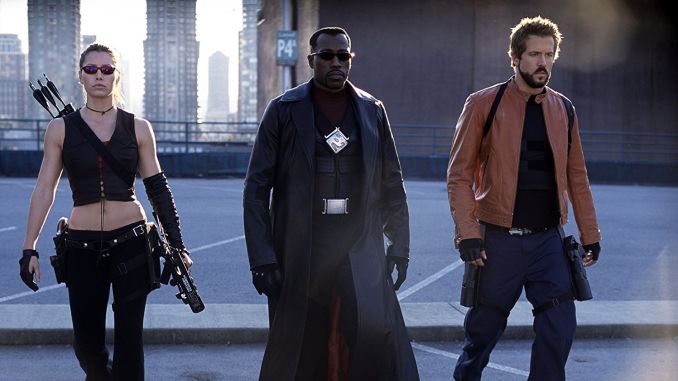
Blade: Trinity (2004)
Rating: B-
Dir: David S. Goyer
Star: Wesley Snipes, Ryan Reynolds, Parker Posey, Jessica Biel
Or Deadpool 0, as it should perhaps be called. For Hannibal King is – perhaps unwittingly on Reynolds’s part – much the same acidic, foul-mouthed exponent of hyperviolence we’d come to know and love. The similarities were not lost on some people. According to the actor, a Fox executive gave him a stack of Deadpool comics on set, and told Ryan, “Seeing as you’re essentially playing this guy anyway, maybe you should play him for real.” Twelve years later, Reynolds did, to enormous commercial and critical success – though those two movies leave this looking like something between an audition tape and a slightly underwhelming imitation.
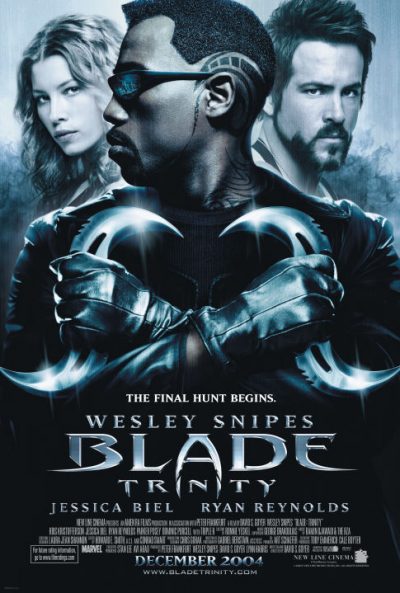 It does certainly bear the closest similarities to the team-up films which would eventually become the cornerstone of the Marvel Cinematic Universe. I’m not certain this works for Blade, who has never felt like the most sociable of guys. In the second film, while there was a collaboration, it was strictly one of necessity, with no love lost on either side. That felt more appropriate: here, Blade seems like the guy who really does not want to be at the office Christmas party. Admittedly, he owes his colleagues a debt. For after Blade is exposed by a sting operation, he’s captured by the FBI and is just about to be handed over to the vampires when King and Abigail Whistler (Biel) break him out of custody.
It does certainly bear the closest similarities to the team-up films which would eventually become the cornerstone of the Marvel Cinematic Universe. I’m not certain this works for Blade, who has never felt like the most sociable of guys. In the second film, while there was a collaboration, it was strictly one of necessity, with no love lost on either side. That felt more appropriate: here, Blade seems like the guy who really does not want to be at the office Christmas party. Admittedly, he owes his colleagues a debt. For after Blade is exposed by a sting operation, he’s captured by the FBI and is just about to be handed over to the vampires when King and Abigail Whistler (Biel) break him out of custody.
Meanwhile, their enemies, under Danica Talos (Posey) have awakened the Big Bad: Vampire Zero, as it were, the father of their entire species. Drake (Dominic Purcell) has powers that dwarf all other vampires, and Talos wants to use them to make the rest of her race invincible. Drake’s blood, however, is all the Nightstalkers need to complete work on Daystar, a bioweapon that will wipe out vampires entirely. Oh, yeah, and there’s a whole subplot about vampires farming humans in this giant warehouse for their blood. It never goes anywhere of note, which is something of a shame: the same is true for the reaper pomeranian, an experimental animal whose potential is sadly under-realized.
Perhaps they were victims of a thoroughly troubled shoot. Snipes was unhappy with the studio’s original choice of director, no more satisfied with Goyer, and only came out of his trailer to do close-ups, according to Patton Oswalt, who plays one of the Nightstalkers. This would explain why Blade seems particularly dead-pan, even by the high standards of taciturn-ness set in the previous two movies. Reynolds does much of both the dramatic and comedic lifting here, and certainly steps up to the plate. King likely peaks when he calls Talos a “cock-juggling thundercunt,” the kind of phrase I feel should become part of everyday speech.
The results are still a good deal of fun, though if it wasn’t for Reynolds’s snark, it easily to see how it could all have gone totally south. Having pitched its hero against Dracula – something Buffy managed to avoid until the fifth season – you’ve more or less reached the top of the vampire-hunting mountain. It’s perhaps no bad thing the franchise went into its coffin for a bit of a nap, rather than churning out a series of likely devalued sequels [again: let’s not mention the TV series, m’kay?] But James Wan apparently pitched a reboot of the franchise a few years back. Maybe Aquaman and Blade have a team-up in their future, hunting underwater vampires.
What we said then: Evidence that in cinema, execution is almost as important as inspiration, the final (for now – box-office pending, no doubt) installment of the trilogy does the lamest thing possible in a vampire film. It resurrects Dracula (Dominic Purcell). Oh, please…even Buffy didn’t succumb to that cliche until season five, and did it with appropriate tongue-in-cheek. Here, it’s played totally straight, which signifies a lack of imagination that’s unfortunate, especially compared to its immediate predecessor, and the only scene with any invention is the “blood farm”, an angle that is almost immediately discarded. This is a nasty surprise, given that Goyer worked on the script for the first two films; you’d think he’d have come up with something equally imaginative for his debut as a director. One sequence, involving a Pomeranian dog, shows the direction they perhaps could have taken.
Fortunately, the execution is rousing enough to prevent this ending up like Van Helsing, mostly thanks to the addition of the quirky Reynolds as an endearingly irritating sidekick. I think I was finally won over, when he called Parker Posey’s vampire queen a “cock-juggling thundercunt”. Or maybe I misheard. 😉 Purcell, as Dracula, is an utter non-entity, and you wonder why they bothered casting him at all, as he brings nothing to the party. Snipes, of course, is Blade, and his portrayal remains among the coolest comic-book characters ever brought to the screen, while Biel and Posey add appropriate sneer (though the former’s iPod use is among the most painfully obvious product-placement of the year). The action, while lacking the flair Donnie Yen helped bring to part 2, is competently-handled and frequent enough you should never be bored. Given its origins in the pulpiest of pulp fictions, this isn’t so terrible – just something of a disappointment.
